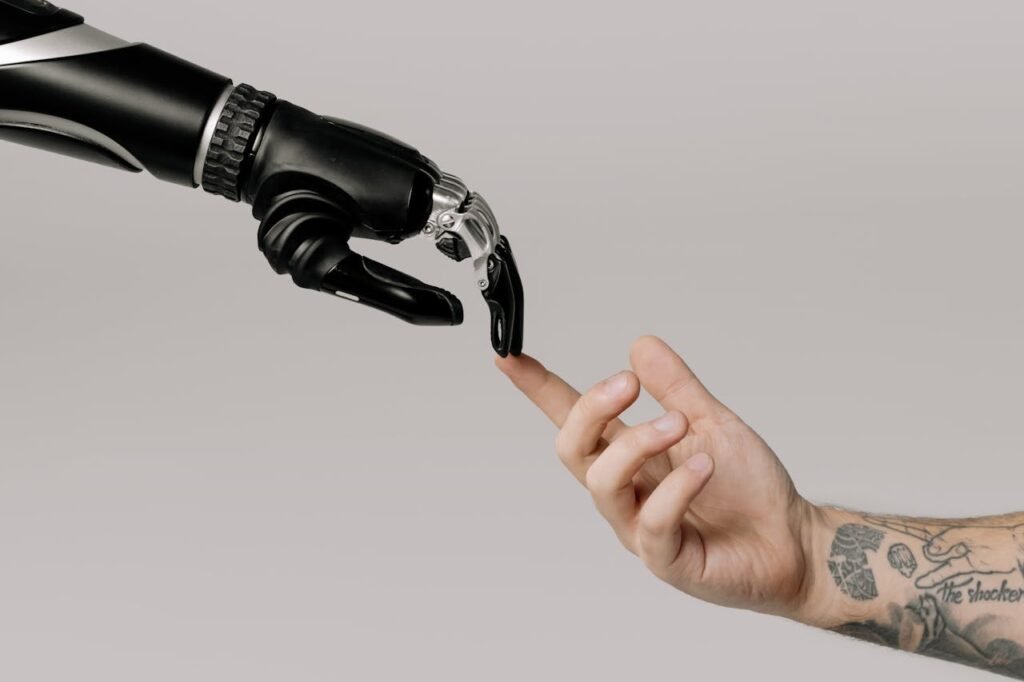Prosthetic hands have come a long way in the last few decades. From simple wooden limbs to modern myoelectric hands, the progress has been remarkable. But now, with the rise of artificial intelligence and advanced robotics, we are entering a new era—one where prosthetic hands are smarter, faster, and more intuitive than ever before. These new advancements are changing lives by helping users feel more in control of their movements and more connected to the world around them.
At Robobionics, we have seen firsthand how AI and robotics are transforming what’s possible. Today’s prosthetic hands can respond faster, grip more naturally, and even learn from the user’s habits over time. In this article, we’ll explore how artificial intelligence and robotic systems are working together to create the next generation of prosthetics—and why this matters for users, especially those with trans-radial limb loss.
This is not just about technology. It’s about people gaining back their independence, adapting to everyday life with more ease, and feeling empowered with tools that truly respond to them. Let’s dive into how this transformation is unfolding.
Smarter Grip Control with AI-Based Learning
One of the biggest improvements in prosthetic hands today is the ability to adapt to the user’s movement patterns. AI-based prosthetics are designed to learn from how a user moves, responds, and uses their hand during daily activities. These systems use sensors placed inside the socket or on the skin to pick up muscle signals. But the difference now is that AI helps the hand understand those signals more clearly and react more accurately.
Understanding How AI Learns from the User

Over time, the AI system begins to recognize patterns. If the user often grabs a water bottle a certain way or types on a keyboard in a certain rhythm, the prosthetic can remember these motions and make future actions smoother and faster. This learning makes the hand feel less mechanical and more natural.
Instead of the user always adjusting to the hand, the hand begins to adjust to the user. That shift is key. It creates a better relationship between the person and the prosthetic, one that feels more human, less robotic.
Adapting to Different Environments Automatically
AI-enhanced prosthetic hands also bring a powerful benefit: adaptability. In the past, prosthetic users had to manually switch grip modes or adjust how they held different objects. With AI, the hand can detect the weight, shape, and type of object being held and automatically change its grip strength and finger positioning.
For example, if someone picks up a fragile item like a glass, the AI can recognize the need for a softer grip. If that same person then lifts a heavier object like a grocery bag, the prosthetic can tighten its grip to give better support. This change happens instantly, and the user doesn’t have to think about it.
This kind of intelligent response makes daily tasks safer and easier. It reduces errors, prevents drops, and gives the user more confidence in how they interact with their surroundings. For people using their prosthetic hand every day, these small improvements add up to big changes.
Continuous Feedback and Improvement Over Time
Another strength of AI is its ability to get better over time. Unlike traditional prosthetics that function the same way each day, AI-based systems evolve. They gather data from every use, analyze what worked and what didn’t, and adjust their responses.
If a user struggles with a certain grip, the AI system can tweak the timing or pressure the next time that motion is attempted. If a particular gesture is used frequently, the hand can make that motion easier to perform in the future. This kind of feedback loop creates a truly personalized experience.
For users, this means their prosthetic hand doesn’t stay static. It grows with them. Whether someone is returning to work, learning a new hobby, or recovering their strength, the prosthetic hand is learning right along with them.
Robotic Precision and Natural Movement
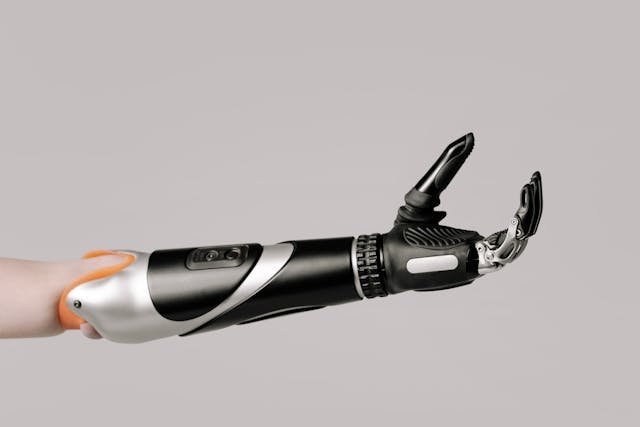
Robotics plays a central role in how prosthetic hands move today. Unlike older designs that relied on simple open-and-close actions, robotic systems allow for precise control of individual fingers, wrist motion, and even fine motor coordination. This precision is made possible by advanced motors, sensors, and control algorithms built into the hand.
The Role of Robotics in Movement Control
Robotics lets the prosthetic hand respond quickly and accurately to signals sent from the muscles. It also makes it possible to carry out multiple actions at once, such as gripping, rotating, and adjusting pressure. This level of coordination brings the prosthetic hand closer to mimicking natural human hand movement.
For users, that means smoother gestures, better balance, and the ability to perform more complex tasks. Tasks like tying shoelaces, holding a pen, or picking up small objects become more realistic and achievable with robotic control.
Reducing Delay and Improving Reaction Time
One of the limitations of early prosthetics was the delay between the user’s intent and the hand’s response. Robotic systems, especially those guided by AI, reduce that delay dramatically. When a user contracts a muscle, the signal travels to the prosthetic almost instantly, and the robotic system responds right away.
This fast reaction time makes the prosthetic feel more like a part of the user’s body rather than an external device. It also makes activities like driving, typing, or sports much more practical and comfortable. The quicker the hand responds, the more naturally the user can move.
With continued development in microprocessors and motion sensors, today’s robotic hands can even predict what movement is coming next. That gives the user a feeling of fluid motion, instead of stiff or forced gestures.
Mechanical Strength without Sacrificing Comfort
Robotic hands are not only precise—they’re strong. Modern actuators inside the prosthetic can lift and hold heavy objects without straining the user’s limb. This strength doesn’t come at the cost of comfort, though. The latest designs use lightweight materials like carbon fiber and 3D-printed structures that reduce the load on the limb.
At Robobionics, we focus on building robotic hands that are both strong and ergonomic. We make sure that users can perform demanding tasks like lifting bags, working with tools, or using gym equipment—without the prosthetic feeling heavy or tiring.
This balance between power and comfort is what makes robotic prosthetics ideal for active users, professionals, and anyone who wants a hand that keeps up with their lifestyle.
Human-Machine Interface: Making the Connection Feel Natural

A major challenge in prosthetics has always been understanding what the user wants to do. This is where EMG, or electromyography, comes in. EMG sensors read tiny electrical signals from the muscles in the residual limb and send those signals to the prosthetic hand.
How EMG Sensors Help Read Intentions
With AI and robotic integration, these signals are translated more accurately and quickly than ever before. The hand doesn’t just move—it moves in the way the user expects. If a person wants to pinch, the prosthetic doesn’t guess—it performs a pinch. If the person wants to make a fist, the hand responds instantly.
This connection is what makes the prosthetic feel like part of the body. The user doesn’t have to think about every movement—they just act, and the prosthetic follows. It’s this natural flow that creates trust between the user and their device.
Reducing Mental Fatigue for Users
Before AI and robotic integration, users often needed to focus hard just to perform basic actions. This mental load made prosthetic use tiring, especially for long periods. With smarter systems, the prosthetic now does more of the thinking, allowing the user to move more freely.
By reducing the effort needed to control the hand, users can wear it longer without stress. They can multitask, talk while performing actions, or go through a busy day without constantly adjusting their movements.
This reduction in mental fatigue improves not only comfort but also emotional well-being. Users feel less like they’re managing a machine and more like they’re just using their hand.
Building Emotional Confidence Through Better Design
When prosthetics move naturally and respond intuitively, users feel more confident in social and professional settings. They no longer feel the need to hide their hand or explain how it works. The design speaks for itself through motion and ease.
At Robobionics, we’ve seen users return to work, school, and sports simply because they trust their hand. That trust is built from hundreds of small moments—opening a door, shaking hands, holding a cup—where the hand works just as it should.
This emotional confidence is just as important as physical ability. When the prosthetic feels like a natural part of you, it boosts your self-esteem and makes everyday life more fulfilling.
Personalization and User-Centered Design in AI Prosthetics
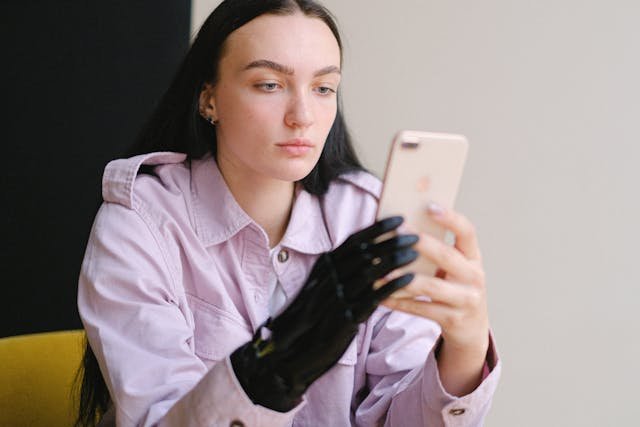
The future of prosthetic hands isn’t just about advanced features—it’s about making sure those features fit each user’s unique lifestyle, goals, and personality. Personalization has become a major focus in AI and robotic prosthetics, helping ensure that the device isn’t just functional, but also feels like it truly belongs to the individual wearing it.
Designing for Individual Needs and Goals
Every person using a trans-radial prosthetic has a different story. Some are students, others are parents, athletes, engineers, or artists. Their prosthetic should reflect the way they live. AI-powered systems make this possible by learning the user’s routines, preferences, and frequent motions, allowing the hand to adjust its behavior accordingly.
For example, someone who cooks regularly may use a wide grip often, while a computer user may need delicate finger control. Instead of a one-size-fits-all approach, AI-driven prosthetics now adapt to each user’s environment and tasks. This makes everyday actions faster, easier, and more efficient.
Robobionics designs prosthetics with this kind of adaptability in mind. From the first consultation to final fitting, we make sure that the prosthetic hand works not just in the clinic—but in the real world, where each user lives, moves, and thrives.
Adapting to Lifestyle Changes Over Time
Life is not static. Over time, people change jobs, pick up new hobbies, or go through life events that affect how they use their prosthetic. AI systems built into today’s robotic hands are designed to evolve along with the user, learning new patterns and adjusting their settings to suit changing needs.
This adaptive nature ensures that the prosthetic continues to be helpful—not just now, but years into the future. Whether someone starts a new sport, travels frequently, or begins caring for a child, their prosthetic can support those new tasks without needing to be replaced or reprogrammed manually.
The result is a more responsive experience that grows with the user, offering flexibility that older prosthetic systems could never achieve. It turns the prosthetic from a fixed tool into a lifelong companion.
Enhancing Comfort Through Customized Fit and Feedback
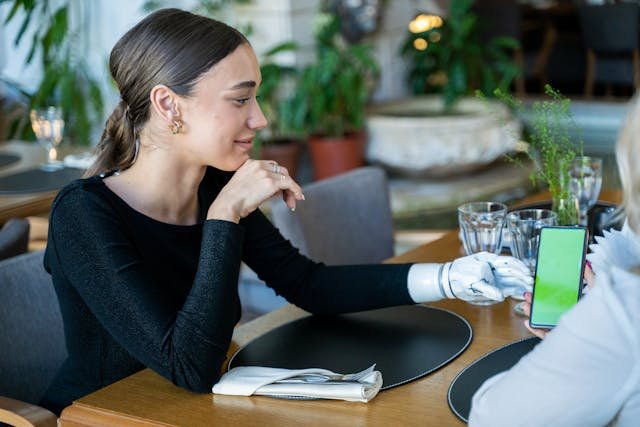
Personalization also applies to how the prosthetic fits. A good prosthetic hand must feel secure but never tight, supportive but never heavy. AI technology now helps create smarter socket systems that adjust to daily swelling, muscle movement, and temperature shifts, providing better comfort throughout the day.
In some designs, real-time pressure sensors inside the socket send feedback to adjust how the prosthetic aligns with the residual limb. This kind of feedback ensures the user experiences less irritation, fewer adjustments, and a smoother wearing experience from morning to night.
Comfort builds trust. When users feel at ease wearing their prosthetic, they’re more likely to wear it longer, rely on it for more tasks, and feel emotionally connected to its value. At Robobionics, this connection is at the heart of every design we create.
The Future of AI and Robotics in Prosthetic Development
The journey of prosthetic technology is far from over. AI and robotics are not just transforming the present—they are shaping an exciting future where prosthetic hands could become even more responsive, more intuitive, and more connected to the human body than ever before.
Integrating Sensory Feedback and the Sense of Touch
One of the biggest breakthroughs on the horizon is restoring the sense of touch. Current prosthetics help users move, grip, and lift—but they still lack natural sensation. Researchers and engineers are working on prosthetic hands that can send feedback to the user’s nervous system, allowing them to feel pressure, texture, and temperature.
This means that a person might one day be able to feel the softness of fabric, the warmth of a cup of tea, or the firmness of a handshake through their prosthetic. This advancement will not only improve safety and functionality but also strengthen the emotional bond between the user and their prosthetic.
With touch integrated, prosthetics will stop being just tools. They’ll become extensions of the human body, offering a truly lifelike experience that was once only imagined in science fiction.
Smarter Connectivity Through the Internet of Things
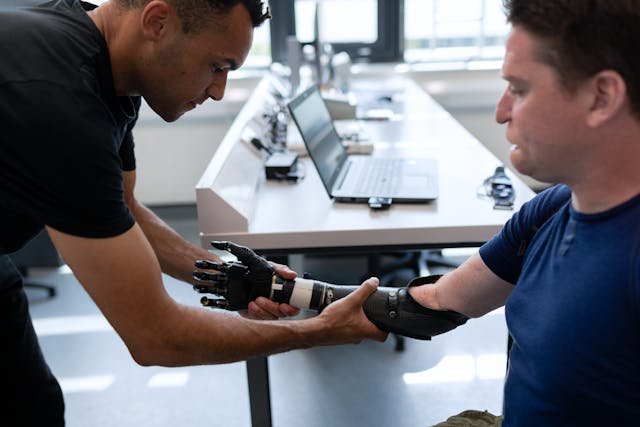
AI-enabled prosthetics are also expected to connect with other smart devices. Imagine a prosthetic hand that could sync with your smartphone, adjust grip for carrying grocery bags, or alert you if something needs maintenance—all in real time. This level of smart connectivity will allow users to manage their prosthetics just like any modern smart device.
These intelligent systems may also connect with healthcare providers, sharing usage data to help improve performance or detect early signs of discomfort. This would allow for proactive care, reducing downtime and improving user satisfaction.
At Robobionics, we see this kind of seamless integration as part of a bigger mission: to make prosthetics not just wearable, but truly livable—devices that work quietly in the background, making life easier every day.
Expanding Access Through Affordable Innovation
As AI and robotics continue to advance, one important goal is making these powerful technologies accessible to more people. In many parts of the world, including India, cost has always been a barrier to getting high-quality prosthetics. But with local innovation, 3D printing, and smart materials, the gap between high-tech and affordability is closing.
Robobionics is proud to be part of this movement. We believe advanced prosthetics should not be a luxury—they should be a right. By designing cost-effective robotic hands without compromising performance, we’re helping more people experience the power of AI-driven prosthetics across urban and rural communities alike.
The future is not just about what prosthetics can do. It’s about who can access them—and how they can help people live with dignity, confidence, and independence.
Conclusion: The Human Potential Behind the Technology
AI and robotics are transforming prosthetic hands into tools of possibility. They are turning limitations into capabilities, hesitation into action, and uncertainty into confidence. For trans-radial amputees, this is more than a shift in design—it’s a new beginning where technology listens, adapts, and grows with them.
At Robobionics, we are not just building prosthetic hands—we are building futures. Our focus is on blending smart technology with compassionate design, ensuring every hand we create empowers someone to live more freely and fully. Whether you’re returning to work, learning a new skill, or simply opening a door with ease, your prosthetic should move with you—and for you.
If you’re ready to experience the next generation of prosthetic hands, powered by AI and robotics, contact us today. Let’s take the next step forward—together.



